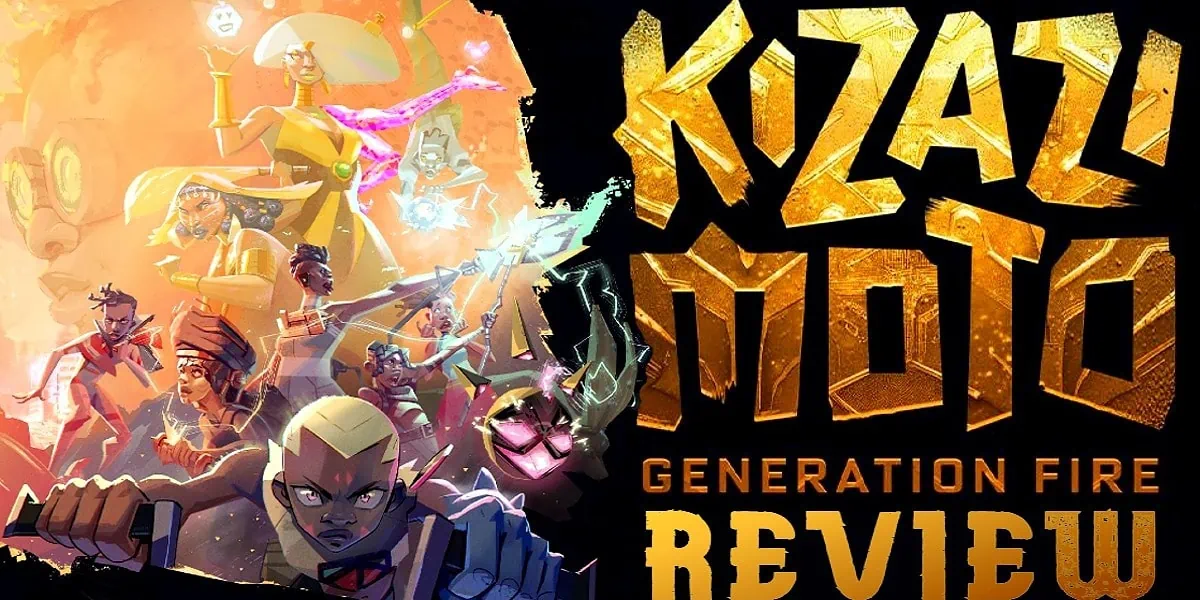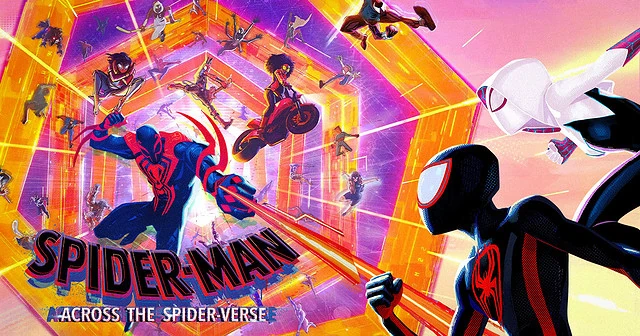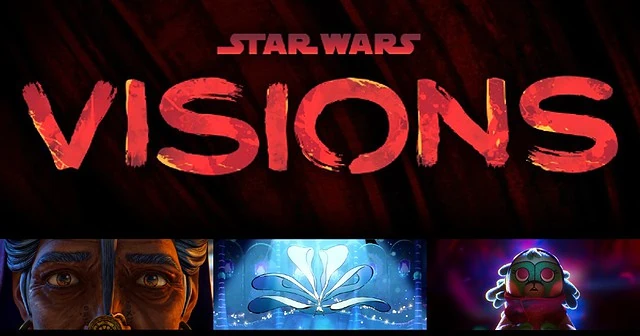Kizazi Moto: Generation Fire is a series of animated short films overseen by Triggerfish Animation Studios. Similar in concept to Star Wars: Visions, each 10-minute episode has their own visual style and story. Kizazi Moto uses the animated anthology format to explore Afrofuturism and the cultures, themes, anxieties and art of Africa.
I was particularly excited for this series because Triggerfish created “Aau’s Song”, which was my favorite episode of Star Wars: Visions season 2. Adding to the immense talent is executive producer Peter Ramsey, the Academy Award-winning co-director of Spider-Man: Into the Spider-Verse. Ramsey’s presence is felt throughout the series, as each episode shares Spider-Verse’s special blend of stunning animation and heartfelt emotional resonance.
The series is also clearly inspired by Marvel Studios’ Black Panther for its exploration of how technology relates to traditionalism, spirituality and nature through the perspective of African culture. Using the limitless scope of science-fiction, each episode is set in a different world with its own interesting rules, cultures, styles, and fears, so that each episode brings something new worth watching. The series features recurring commentaries on major topics that are relevant around the world today, including religion, spirituality, social media, coming-of-age, and societal anxieties.
All ten episodes drop July 5 on Disney+, so check out our reviews below for an early sneak peek!
Kizazi Moto, Episode 1 – “Herderboy” (Uganda)
“Herderboy” is created by Raymond Malinga with Mpho Osei-Tutu, and features Black Panther’s Florence Kasumba. The short was produced by Triggerfish Animation Studio with music by Jordan Bridges, James “Ssewa Ssewa” Ssewakiryanga, and Mpho “37mph” Pholo.
“Herderboy” has some of the most evident Black Panther inspiration across Kizazi Moto. Set in the mystical Chewzi Kingdom in the highlands of Uganda, the short uses a dramatic coming-of-age story to investigate technology’s relationship with nature. There are also some spectacular visual aesthetics, and I loved the fun cyborg elements in the characters designs.
Kizazi Moto, Episode 2 – “Moremi” (Nigeria)
“Moremi” is created by Shofela Coker, with Andrew McNally and Vanessa Kanu, based on the real Queen Moremi of Ife. The short was produced by Lucan Studio with music by James Frank, Femi Koya, and Olaolu Lawal.
I thought the spiritual “past lives” story of “Moremi” was a bit complex, but the visuals were enough to carry the emotional experience. The majority of the episode has blocky 3D designs and movements inspired by stop motion, yet the true highlights are the stunning 2D animated sequences.
Kizazi Moto, Episode 3 – “Surf Sangoma” (South Africa)
“Surf Sangoma” is created by Catherine Green and Nthato Mokgata, with Graham Gallagher, Terence Neale, and Phumlani Pikoli. Pre-production on the short was done by Chocolate Tribe, with the main production by Triggerfish Animation Studios. The music was composed by Kojo “Lion” Dodoo, Aero Manyelo, and Pierre-Henri Wicomb.
“Surf Sangoma” has a very cool horror style but the story and animation didn’t feel as boldly unique as the other episodes. The plot follows two friends in South Africa who make a bad deal in order to pursue their passion for surfing. The short uses mainly 3D animation with 2D highlight effects similar to Ramsey’s Spider-Verse films.
Kizazi Moto, Episode 4 – “Enkai” (Kenya)
“Enkai” is written and directed by Ng’endo Mukii. The short was produced by Blink Industries with music by Zap Mama and K.Zia.
This is my favorite episode of Kizazi Moto by far. “Enkai” is a beautiful creation myth about a young goddess and her aging mother. The short is loaded with social commentary, and features an incredible blend of 3D/2D animation, as well as stop motion. This features some of the best animation, music, and character designs of the entire anthology, on top of a powerful story about humanity, nature, belief, and family generations.
If you want to watch only one episode of Kizazi Moto, “Enkai” is my top recommendation.
Kizazi Moto, Episode 5 – “Mkhuzi: The Spirit Racer” (South Africa)
“Mkhuzi: The Spirit Racer” is created by Simangaliso “Panda” Sibaya and Malcolm Wope, with Leslie Pulsifer. The short was produced by Studio Meala with music by Sek Hao Ho, Prisca Leong, Tinashe Makura, Anton Morgan, Sean Ross, Oliver Stutz, and Adrienne Yong.
Among the more spiritual episodes of Kizazi Moto, “Mkuzi” is about a young boy stepping into his mother’s podracing shoes to save his community. The episode features more stronger social commentary than many of the other episodes, but I felt the literal story and pacing were weaker. The fast, bright, and colorful 2D animation gives the episode a fun anime style, while keeping a distinctly African flair.

Kizazi Moto, Episode 6 – “You Give Me Heart” (South Africa)
“You Give Me Heart” is created by Lesego Vorster with Nonzi Bogatsu. The short was produced by Portfolio Animation Studio, with music by Zethu Mashika.
“You Give Me Heart” is one of the funniest and most relatable episodes of Kizazi Moto. The story takes place in a world where social media influencers can become literal gods. The episode features pretty art, with heavy commentary on artists, creativity, and the facades of influencer culture.
Kizazi Moto, Episode 7 – “Mukudzei” (Zimbabwe)
“Mukudzei” is created by Tafadzwa Hove and Pious Nyenyewa. The short was produced by Saturday Animation Studios with music by Zyon Black, Darlington “Young DLC” Chikwewo, Tapiwa Mubeda, and Poptain.
This was my second favorite of the set. “Mukudzei” features photorealistic 3D animation, cool music, and a real sense of heart. The story features a young hero who unlocks the secret passage to an alternate reality. Through friendship, monsters, and grief, the short explores what happens when you leave home and the importance of family.
Kizazi Moto, Episode 8 – “Stardust” (Egypt)
“Stardust” is created by Ahmed Teilab with Voline Ogutu, and features an Egyptian cast led by Laith Nakli. The short was produced by Triggerfish Animation Studios with music by Amir Hedayah.
This was another one of my favorites. The beautiful 3D animation of the world looks like Star Wars: The Clone Wars or the India-produced episode of Star Wars: Visions. The story follows a girl who wants a “destiny” so badly that she tries to steal it. When things go awry, she gets lost on a fun epic saga with emotions, twists, and a strong character arc. Features great action, giant creatures, and desert chases!
Kizazi Moto, Episode 9 – “First Totem Problems” (South Africa)
“First Totem Problems” is created by Tshepo Moche, with Maame Boateng, and Khadidiatou Diouf. The short was produced by Giraffics, with music by Kay Faith, Rethabile Khumalo, and Joe-Louis Marques.
“First Totem Problems” has a wacky central idea but the heart of the story is great. A girl wants to get her “coming-of-age” totem but when she pushes too hard, she accidentally ends up in the ancestral plane and has to find her way back home. The episode is really fun, with bouncy music and fluid 2D animation featuring CG, cutouts, and painted backgrounds. I love the bright beautiful colors and the wonderfully exaggerated style of the world. The direction and style of this episode are among my favorite in the whole series, but some of the heavy satire and script didn’t click for me as well as the other episodes. But I’m sure other viewers might enjoy this more!
Kizazi Moto, Episode 10 – “Hatima” (South Africa)
“Hatima” is created by Terence Maluleke and Isaac Mogajane, with Tatenda Mbudzi. The short was produced by Studio Meala with music by Zethu Mashika.
“Hatima” is a really cool creation myth about the birth of an African Atlantis. The story smoothly alternates between two compelling dramas with powerful messages about rejection and acceptance. This was another strong episode with bright colors and 2D animation. My favorite parts were the emotional resolutions at the end and how the parallel storylines connect together meaningfully. This is one of the more timeless episodes that feels relevant for any generation.

My verdict on Kizazi Moto: Generation Fire
It’s so inspiring to have an entire Disney cartoon dedicated to Afrofuturism and African societies. There is so much detail in the textures and world-building of each episode. Beyond the visuals, this also extends to the score throughout. From musical cues to lyrical songs to Brian Soko’s credits theme, Kizazi Moto has a special soundtrack that is worth seeking out for its own merit. I am overjoyed by the creators’ commitment to cultural authenticity, giving the audience complete immersion into sights and sounds of these worlds.
Kizazi Moto is one of the most culturally important projects Disney has ever done. The series is an incredible celebration of African art, culture, and storytelling, the scope and ambition of which is unrivaled in animation history. From creation myths to crazy monsters, Kizazi Moto: Generation Fire is a tour de force of creative mastery. It was a privilege to watch these episodes, and I can’t wait to see what these incredible creators do next!
Are you excited for Kizazi Moto: Generation Fire? Which episodes sound the most interesting to you? Let me know on Twitter @vinwriteswords and remember to follow the site @MyCosmicCircus for more coming soon!
‘Across the Spider-Verse’ Review: A Revolutionary Animated Experience





